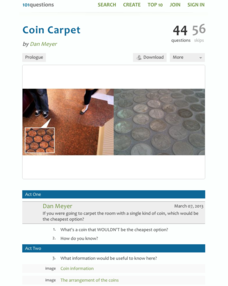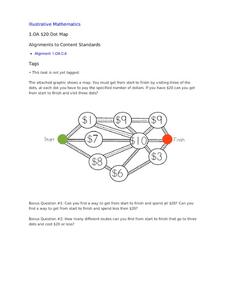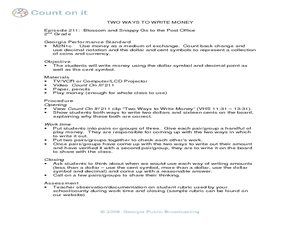Curated OER
The Dollar Cookie
Second graders recognize, count, and write money amounts using the cent symbol and identify equivalent amounts of money. In this money lesson plan, 2nd graders add money amounts using plastic coins and magnetic money.
Curated OER
Why Does Money Have Value?
Learners study money and its value and usage in the world today. In this economic lesson, students research money as they learn what it stands for, why it is important, how it is valued and what it represents in the United States.
Curated OER
Our Town Store
Students purchase items in their classroom store. In this money instructional activity students create a classroom store. The students have a given amount of money and have to decide if they have enough to purchase the items that they...
Curated OER
The Big Buck Adventure: Part 2
Students go on a pretend shopping spree. In this money lesson, students complete a Shopping Spree activity sheet where they pretend they have won $100 and can spend it on a fake shopping spree. Students use the Internet to shop and...
Curated OER
Burning a Hole in Your Pocket
Students solve word problems. In this money lesson, students solve math word problems dealing with money and then write down all the steps necessary to solve the problems. Students use given websites to practice more math problems.
Curated OER
Cent Sense
Learners identify money values. In this money instructional activity, students sort and group coins by value and investigate the cost of supplies needed for a snack. Learners prepare snacks for a snack sale.
Curated OER
Let's Go Shopping!
Students answer yes or no to the question "Could you buy the items below with only having $6 to spend?". In this money lesson plan, students multiply amounts of money in each problem to see how much they have to spend.
Houghton Mifflin Harcourt
Simple and Compound Interest
Your learners will get lots of practice calculating simple and compound interest by the end of this lesson. Simple explanations and examples lead learners through the concepts and steps of calculating simple and compound interest...
Federal Reserve Bank
Savvy Savers
What are the benefits and risks of saving in an interest-bearing account? Pupils explore concepts like risk-reward relationship and the rule of 72, as well as practice calculating compound interest, developing important personal finance...
101 Questions
Coin Carpet
Here's a new meaning to the expression throwing away money...a carpet of coins! An intriguing lesson requires calculations to determine the coin that would be the cheapest option, but it's a little tricky. The cost of the coin changes,...
Concord Consortium
Vending Machine
Let the resource quench your thirst for knowledge, like a vending machine that dispenses drinks. Future computer scientists develop an algorithm to identify the fewest number of coins that a vending machine could use in creating change....
Illustrative Mathematics
Coupon Versus Discount
All too often stores give coupons for an item, but when you go into buy it, the item is on discount. The store won’t take the coupon if the discount is used. So what do you do, use the coupon or take the discount? This activity helps...
Illustrative Mathematics
$20 Dot Map
Challenge the addition skills of young learners with this open-ended math problem. The task is simple, get from start to finish by connecting a series of three numbers. The trick is that the sum of the numbers must be less than or equal...
Practical Money Skills
Student Loans
If your learners are college bound, they'll need a lesson about student loans and personal finance before they step into their dorm room. A four-day lesson guides high schoolers through the process of budgeting for college, as well as...
Practical Money Skills
Living on Your Own
Every teen dreams of living independently, but often without thinking about the details and costs involved with moving out. Three lessons in a unit about living on your own focus on moving costs, fixed and flexible costs associated with...
101 Questions
Would You like Fries with Your Order?
Ever wonder what you are paying for a single fry at McDonald's? An engaging lesson compares the cost per fry in a small order to a larger order. It's a great application of unit rate that is sure to make your classes hungry for more!
Curated OER
Scarcity and Choice
After reading the book A Bargain for Frances, young economists discuss how money is exchanged for goods or services. They demonstrate effective financial decision-making by listing ways to save money for a product they would like to buy.
Curated OER
Who's On First?
Have you ever considered why the number 10 is so important to us? That's what learners do here. They explore patterns formed by powers of ten and by decimals, convert units of measure within the metric system, and express these in the...
Curated OER
Two Ways to Write Money
Second graders complete activities to learn about money and how to write money. In this money instructional activity, 2nd graders watch a video about ways to write money. Students work in groups with play money and come up with two ways...
Curated OER
Buying in Bulk
Students investigate buying purchases in bulk. In this buying in bulk lesson, students consider ways to cut costs and reduce waste in landfills by making bulk purchases.
Texas Commission on the Arts
The Quarter Fold
Little ones identify the US quarter and explore the concept of one-fourth or one-quarter. Using real coins or coin manipulatives, they divide a square piece of paper into quarters, discuss halves and quarters, and create a design that...
Curated OER
Pocket Change
Young scholars practice identifying coins and their values. For this money identification lesson, students play a game, where they toll a coin, determine the value, and compare totals to win.
Curated OER
Number Cents
Students identify the value of coins. In this number cents lesson, students use coins to create sets of equivalent values. They create patterns with coins and write the value of coins in two forms. Students count the value of given coins.
Curated OER
Shopping for Candy
Students explore counting money. In this money counting and gingerbread house construction lesson, students use a calculator to determine how much and what type of candy they can buy given 25 cents. Students construct gingerbread houses...
Other popular searches
- Money Math Lessons
- Counting Money Math Lessons
- Autism Money Math Lessons
- Shopping Money Math Lessons
- Math Lessons With Money
- Math Lessons on Money
- Money Math Lessons for Life

























